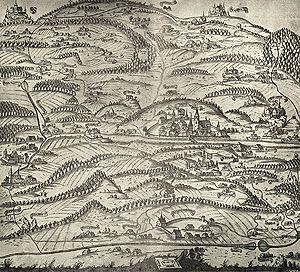
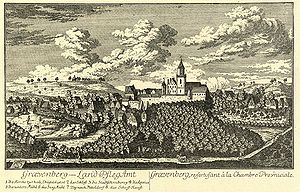
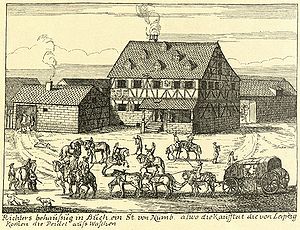
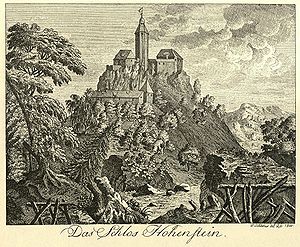
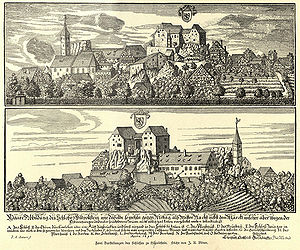
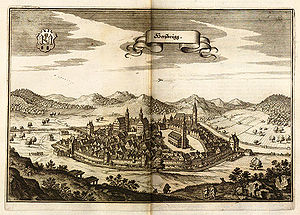
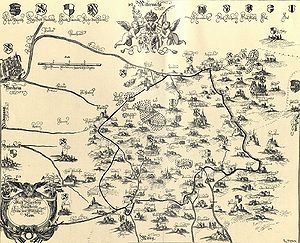
The Imperial City of Nuremberg had one of the largest imperial territories with about 1,200 square kilometres. The territory was divided into the "Alte Landschaft" and the "Neue Landschaft". The “Alte Landschaft”, which included the Imperial forests, was a conglomerate of the dominions and estates of Nuremberg citizens, monasteries and social institutions. However, the highest penal justice, the “Hochgerichtsbarkeit” ("Cent", "Fraisch") pertaining to this territory lay with the Burgraviate or Margraviate of Ansbach and Kulmbach-Bayreuth, which was a source of constant conflict. The “Neue Landschaft” was given to Nuremberg in 1505 as war gains from the Landshut War of Succession. Here, in most cases, the city exercised all the sovereign rights. In 1790/91 and 1796 respectively, Bavaria and Prussia occupied large parts of the Nuremberg territory, which was completely taken over by Bavaria in 1806.
Size and structure
Nuremberg possessed the largest imperial cities of all German territory. Its size (approx. 1,220 sq. km) and importance can be compared to those of smaller principalities. Only the imperial city of Bern, which became part of the Swiss Confederacy in 1353, and the imperial cities of Ulm and Strasbourg had roughly comparable land territories. Nuremberg's territory was divided into the "Alte Landschaft", as it had grown up to around 1500, and the "Neue Landschaft", which was about twice as large in area and which the city had conquered in 1504/05 during the Landshut War of Succession. Consequently, it was contractually given to the city in the Cologne Peace Treaty in 1505. About 25,000 people lived within Nuremberg’s city walls around 1790, compared to about 35,000 in Nuremberg's land territory.
Development
The systematic expansion of territorial rule not only of Nuremberg, but of imperial cities in general since the middle of the 14th century had several reasons: the weakness of imperial power, its poor peacekeeping, the debt crisis of the surrounding landed gentry and noble knights with a simultaneous capital surplus in the urban bourgeoisie and the growing need of cities to secure the procurement of food for their inhabitants, to secure the supply of raw materials for their craftsmen and to secure military self-protection.
To facilitate this, cities did not acquire territories, but rather estates and rights, as was customary in the Old Empire's “Altsiedelland” (old settlement land). Expansion into a "territory" only happened during the course of the modern period, if at all.
"Alte Landschaft"
Before the major changes in and after 1790/96 (Bavarian sequestrations and Prussian revindications), the territory of the Imperial City of Nuremberg presented the following picture:
The "Alte Landschaft" was the area outside Nuremberg's city walls, situated mainly between the so-called border waters of the Erlanger Schwabach, Regnitz/Rednitz and Schwarzach. It included the suburbs of Gostenhof (since 1342 the burgrave fief of the Nuremberg Waldstromer, family, since 1477 a Nuremberg administrative office) and Wöhrd (part of the burgraviate office of the Veste, acquired by Nuremberg in 1427, together with the office as a whole) as well as the Sebald and Lorenz imperial forests and the "Knoblauchsland" (garlic land). The imperial forests were the property of the Empire. The imperial fiefdom in the southern (Lorenz) imperial forest was held jointly by the Nuremberg families Waldstromer (acquired by Nuremberg in 1396) and Koler (acquired by Nuremberg in 1372), the one in the northern (Sebald) imperial forest, which also included the Knoblauchsland, was held by the burgraves. The city acquired these fiefdoms in 1427, together with the Burgrave's Castle and the office of the Veste. Some of the imperial city's rights, in particular the High Justice jurisdiction (Fraisch), were disputed by the Burgraves of Nuremberg (the later Margraves of Ansbach/Kulmbach-Bayreuth) from 1427 onwards. In 1583, they were awarded these rights in the trial known as the "Fraischprozess" before the "Reichskammergericht" (Imperial Chamber Court), remaining a constant point of friction between the two nonetheless.
Before 1790, in the "Alte Landschaft", bailiwick and manorial rights were exercised mainly by the two forest offices Sebaldi and Laurenzi, the Gostenhof administrative office and the office of the Veste with the Wöhrd judicial office. The judicial authorities were the courts of the respective subjects, the Nuremberg peasant court, the forest courts of the two imperial forests and the honey hunters’ court in Feucht. Within, but mainly outside the "Alte Landschaft", there was also a huge scattering of indirect dominions and rights for Nuremberg citizens and former ecclesiastical institutions – such as the Nuremberg monasteries secularised in the 16th century – or charitable care institutions, here in particular the "Heilig Geist" hospital. These scattered properties geographically extended from Steigerwald and Franconian Switzerland in the north to the area around Gunzenhausen and Greding in the south, from Ansbach in the west to the Jurabogen in the east. The Nuremberg land alms office alone, responsible among other things for the landed property of the former Nuremberg monasteries, administered estates in over 500 places around 1790. Within the "Alte Landschaft", Nuremberg, including the scattered properties, had about 28,000 people living in 5,780 households in 780 towns and villages in 1497. These serfs were obligated to homage, obedience, military service and the payment of taxes to the imperial city.
"Neue Landschaft"
Acquired in 1504/05, the "Neue Landschaft" was managed by the administrative offices in Altdorf (Nürnberger Land district), Betzenstein (with Stierberg; both Bayreuth district), Engelthal (Nürnberger Land district), Hersbruck (Nürnberger Land district), Hiltpoltstein (bought in 1503; Forchheim district) with Hohenstein and Wildenfels (bought in 1505 and 1511; Nürnberger Land district), Lauf, Reicheneck and Velden (Nürnberger Land district) with Hauseck (Amberg-Sulzbach district). The Gräfenberg (Forchheim district) administrative office, gradually acquired by Nuremberg families or the imperial city between 1347 and 1536, belonged to the "Neue Landschaft" as well as the Lichtenau administrative office near Ansbach, purchased in 1406. The structure of the Nuremberg administrative offices was often based on the pre-1504 Palatinate/ Bavarian office structure.
In 1513, the Nuremberg administrative offices were placed under the newly created regional administrative office as the "mediating authority". In contrast to the "Alte Landschaft", the "Neue Landschaft" administrative offices were territories marked with stones, in which the imperial city undisputedly exercised its judicial, financial and administrative sovereignty. Here, the margraves only disputed the "Fraisch" in the Altdorf and Lauf administrative offices, which partly extended into the imperial forests. The self-administration rights of the towns of Altdorf (from 1575 on also with the academy/university of Altdorf), Lauf, Hersbruck, Velden, Betzenstein and Gräfenberg remained in force even under the Nuremberg administration.
Gradual mediatisation 1790/91-1806
The land territory and its population suffered greatly during both the Margrave Wars (1449/50 and 1552-1554) and the Thirty Years' War due to quartering, looting, the march troughs of troops and diseases.
Once the Electorate of Bavaria had fallen to the Palatinate-Sulzbach line in 1777, the Electorate of Palatinate-Bavaria began to claim the judicial and fiscal rights to Nuremberg's scattered properties in the Upper Palatinate as well as the Heideck and Hilpoltstein offices that belonged to Palatinate-Neuburg. In 1790/91, the Electorate of Palatinate-Bavaria occupied the estates, which Nuremberg had been entitled to since the Landshut War of Succession, citing its old rights (Bavarian sequestrations). Large parts of the Hiltpoltstein, Gräfenberg and Velden offices’ territories were now occupied, which led to corresponding tax losses for Nuremberg. Protests to the Emperor and the Empire were fruitless due to the tense military and political situation. In the game for power over Nuremberg's “inheritance”, the Electoral of Palatinate-Bavaria – with the goodwill and support of France – competed with Prussia, which had been awarded the two Franconian margraviates in 1791. Minister Karl August von Hardenberg (1750-1822) had endeavoured to create a territorially closed Prussian "Franconian province" ever since. When, in 1796, Prussia occupied the district containing the court of High Justice in the "Alte Landschaft" (which the margraves had claimed for centuries) as part of its policy of revindication, Nuremberg was enclosed up to the city walls. Apart from the Lichtenau administrative office, which had been reduced to its High Justice district, and the administrative offices that had been considerably reduced by the Electorate of Palatinate-Bavaria, it was only left with its scattered properties in the Bamberg prince-bishopric.
In 1972, the largest part of the former Nuremberg land territory (especially the “Neue Landschaft”) was combined into the newly created administrative district “Nürnberger Land”.
Documents
References
- Wolfgang Baumann/Michael Diefenbacher u. a. (Hg.), Der Nürnberg Atlas. Vielfalt und Wandel der Stadt im Kartenbild, Colbe 2007, 28f.
- Heinz Dannenbauer, Die Entstehung des Territoriums der Reichsstadt Nürnberg, Stuttgart 1928.
- Michael Diefenbacher, Nürnberg wird bayerisch – ein Überblick, in: Michael Diefenbacher/Gerhard Rechter (Hg.), Vom Adler zum Löwen. Die Region Nürnberg wird bayerisch 1775-1835 (Ausstellungskataloge des Stadtarchivs Nürnberg 17), Nürnberg 2006, 11-28.
- Gunther Friedrich, Zwischen Nürnberg, Preußen und Bayern – die Verwaltung des Nürnberger Landgebiets zwischen 1790 und 1806, in: Michael Diefenbacher/Gerhard Rechter (Hg.), Vom Adler zum Löwen. Die Region Nürnberg wird bayerisch 1775-1835 (Ausstellungskataloge des Stadtarchivs Nürnberg 17), Nürnberg 2006, 61-75.
- Hans Recknagel/Gerhard Rechter (Hg.), Das Territorium der Reichsstadt Nürnberg, Katalog-CD 2004.
- Wolfgang Wüllner, Das Landgebiet der Reichsstadt Nürnberg, Nürnberg 1970.
Sources
- Peter Fleischmann (Bearb.), Das Reichssteuerregister von 1497 der Reichsstadt Nürnberg (Quellen und Forschungen zur fränkischen Familiengeschichte 5), Nürnberg 1993.
Further Research
Cite
Michael Diefenbacher, Nuremberg, Imperial City: Territory, published 10 March 2010, English version published 22 March 2024; in: Historisches Lexikon Bayerns, URL: <https://www.historisches-lexikon-bayerns.de/Lexikon/EN:Nuremberg,_Imperial_City:_Territory > (20.12.2025)
